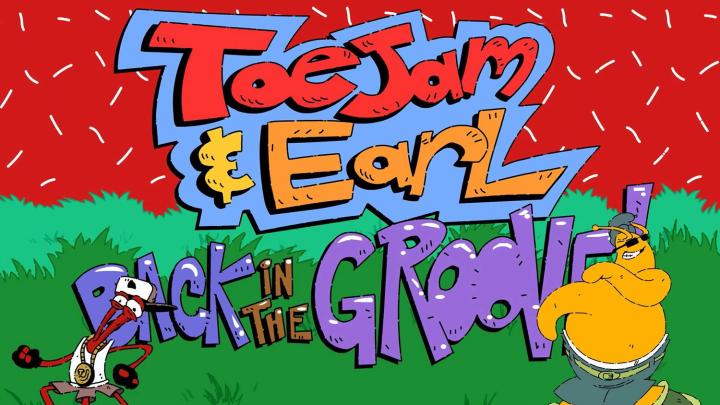
After a few lackluster sequels to the original 1991 classic, many people wrote them off as footnote in gaming history, relegated to hipster nostalgia for the era alongside school-banned slap bracelets and pogs. A recently successful Kickstarter campaign from one of the series’ creators has given the pair new life in the 21st century, however — with a decidedly retro charm.
Let’s take a stroll down memory lane and revisit what those funky aliens were all about.
ToeJam Is a Weiner
The series’ seeds were first planted when creator Greg Johnson was studying at the University of San Diego and fell in love with the groundbreaking dungeon crawler, Rogue (yes, the game that all of those procedurally generated, permadeath affairs so in vogue right now are “-like”). Johnson started working at Electronic Arts — still a tiny operation of 30 or so people at the time — in the late 80s where he contributed graphics to games like Starflight, a seminal space sandbox game. Following the success of those games, Johnson left to form a new company with his colleague Mark Voorsanger to focus on ToeJam & Earl, which they successfully pitched as a cooperative two-player game to Sega of America.
It combined the top-down, semi-random level design of Rogue with the sci-fi themes of Starflight, but with a much lighter, sillier tone. At the start of the game, its eponymous aliens crashed their ship into Earth, shattering into ten pieces, which they had to collect and reassemble in order to escape. Earth is represented by a series of randomly generated islands, floating in space and connected by elevators. Step off the edge of one island and you fall down to land on the next lower one. One player, or two working together, must explore the islands and gather the pieces of their missing ship, while avoiding dangerous “Earthlings,” such as nerds, devils, giant hamsters in balls, chickens with tomato-launching mortars — you know, regular, Earth stuff — and collecting power-ups.
The game was psychedelic satire with a dollop of funk. ToeJam and Earl were dressed in a hyperbolic version of early 90s hip hop fashion that actually wouldn’t seem terribly out of place in a Brooklyn loft party now: backwards baseball cap, high-tops, sunglasses, and a large, gold medallion. The groovy soundtrack combined elements of both jazz-funk and hip hop; composer John Baker cited Herbie Hancock and The Headhunters as major influences. Funk and science fiction have a long history, tracing back through the off-kilter, afrofuturist, cosmic mythology of Parliament Funkadelic.
Despite underwhelming initial sales, the game was praised by critics and developed a cult following through word of mouth. Fans loved its humor, soundtrack, and especially its fun and accessible, cooperative multiplayer. Critics also noted its decidedly non-violent gameplay, with the only way to attack enemies being a power-up that let you toss tomatoes. Funk (capital “F”) is a cosmic force of peace and unity, and ToeJam and Earl are its vessels.
Publisher Panic on Funkotron
Following the original game’s success, Johnson and Voorsanger started work on a sequel in 1992. The game would have played very similarly to the first, adding more items, enemy, and terrain types and trading the randomly-generated levels for larger, fixed maps with secret areas to discover. Johnson and Voorsanger spent three or four months fleshing out the original game’s mechanics before word came down from Sega that the publisher was not pleased with their direction, finding it too strange.
In response, Johnson and Voorsanger changed course and instead developed the sequel, ToeJam & Earl 2: Panic on Funkotron, as a more conventional, two-dimensional platformer, which was much more appealing to the publisher in the immediate wake of the original Sonic the Hedgehog. After returning home to Funkotron, ToeJam and Earl discovered that some of those dastardly Earthlings had stowed away on their ship, and now had to be hunted down. Critics initially praised the game’s lush graphics and tight gameplay, but in time its reputation diminished as fans of the original expressed their disappointment in the loss of its unique and peculiar qualities. Greater immediate accessibility came at the cost of the game’s esoteric appeal.
Not with a Bang, but a Shrug
The third installment took another decade to see the light of day. The poor performance of Sega’s next console, the Saturn, stopped them from developing a version for it. At different times versions were begun for Nintendo 64 and Sega Dreamcast, but neither was ever completed. Finally, in 2002 the Dreamcast version was ported over to the original Xbox with the assistance of Visual Concepts, a studio most noted now for developing the 2K Sports franchises.
Gameplay for the third game, ToeJam & Earl III: Mission to Earth sat somewhere between the first two, allowing for one or two players to explore a series of three-dimensional islands while searching for the twelve Sacred Albums of Funk to return to Lamont the Funkopotamus. ToeJam and Earl were joined this time around by a new, female character named Latisha. Like the first game, it featured randomly generated islands full of dangerous Earthlings. More like the second game, though, it had a greater emphasis on platform-based challenges. Critics gave mixed reviews, with some still praising its humor and graphics, while many others found its hip-hop jargon and style to be embarrassingly dated.
Bringing Back the Funk
The newly-funded Kickstarter project is a long-overdue return to that first sequel that Johnson and Voorsanger originally wanted to make in 1992. The popular mandate of crowdfunding has allowed Johnson to finally prove that what fans wanted all along was more of the first game with which they fell in love. The prototype footage above looks like an entirely faithful recreation of the first game with modern graphics, exchanging pixels for a hand-drawn visual style.
While its early 90s hip hop style might have seemed passé in the early years of the millennium, the relentlessly-shrinking nostalgia gap has ensured that the 90s have become cool again, meaning that the world is finally ready for ToeJam and Earl’s prophesied return.
Did you play any of the three original games? Will you play the new one? Are you excited by the rumblings of a Battletoads revival? Has Pillars of Eternity made you nostalgic for Baldur’s Gate? Sound off in the comments!


